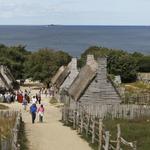Jillian & Ryan
Things To Do

Mayflower Society House
Across the street and around the corner from Plymouth Rock, in the heart of this quaint village’s historic district, is the Mayflower Society House. The grounds host the historic eighteenth century dwelling built by Edward Winslow. Behind this stately mansion are the offices and library of the General Society of Mayflower Descendants. The property overlooks a snug harbor where a reproduction of the blessed ship, The Mayflower, is moored (away for repairs until 2020). Cole’s Hill, the final resting place of many of the Pilgrims, may also be seen. Stop by to take a guided tour of the House, explore the beautiful garden, and visit our library. We would enjoy meeting you, telling you more about our organization and the history of this celebrated site. This 18th century mansion overlooking Plymouth harbor has ten rooms, three centuries of furnishings and artifacts. Nominal admission. Group rates arranged. Hours 2019: Open Wed-Sun 11am-4pm. Check the weblink for updated hours.

Edaville Family Theme Park #forthekids
Located in South Carver, Massachusetts and open since 1947, Edaville Railroad is a two-foot heritage narrow gauge railroad line that works as an excursion train and entertainment park for tourists. One of the oldest railroad heritage operations in the country, Edaville was built by Ellis D. Atwood on his crandberry farm. The park has more than 90 attractions and rides and covers 11.5 acres of the lush, green New England land. Some of the most popular attractions include the Island of Sodor, Knapford Station, Tidmough Sheds, and 11 theme rides such as Harold the Helicopter and Cranky the Crane. Visitors can enjoy a scenic 20-minute train ride on a full-sized Thomas the Tank Engine™ through the entire Edaville USA.

Plymouth Rock -- its a bit anticlimactic #justarock #noteventhatbig
Plymouth Rock is a glacial erratic boulder located in Pilgrim Memorial State Park in Plymouth Harbor. The rock is an iconic symbol of the pilgrims and the faith and courage of the people who made the historic voyage from England to the New World, where they founded the first colony in New England. It is widely believed that Plymouth Rock, a 10-ton massive stone, was the stepping stone pilgrims used to disembark from the tall ship on the shore of the New World, but there is no historical evidence supporting this. The rock was found and identified as a symbolic stepping stone 121 years after the arrival of the Mayflower based on a story told by Thomas Fauce, whose father was one of the pilgrims. Whatever the historic facts, more than a million people visit the rock every year, giving tribute to the symbol of freedom it has become.

Plimoth Plantation
The Plimoth Plantation in Plymouth, Massachusetts provides visitors with personal and powerful experiences with the history of the Plymouth Colony. The site was built upon careful research about the English colony and the Wampanoag People in the 1600’s. Plimoth Plantation today offers an experiential and engaging indoor and outdoor environment for learning on its grounds, as well as at Plymouth’s historic waterfront at the State Pier and the Plimoth Grist Mill located on Town Brook. The many permanent exhibits share the interwoven and complex stories of the two distinct and different cultures of the area: Native and English. These exhibits are enhanced periodically with an array of programs for the public, workshops, and special events that provide a diverse and rich exploration of the seventeenth century.










